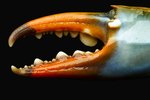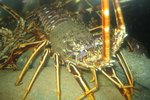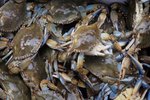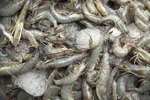Land crabs, as the name implies, are terrestrial invertebrates. Most of these crustaceans burrow in sand or dirt for cover during the day and feed at night. Land crabs can be seen on beaches and near other bodies of water during a full moon, when they come to the nearest water source for breeding. Florida land crabs are found in coastal areas of the Florida peninsula and the Florida Keys.
Cardisoma Guanhumi
The Cardisoma guanhumi species, also known as the blue land crab, can be found near the coasts of southern Florida. Their carapaces grow up to 14 inches wide, making these the largest land crabs in Florida. When these crabs are young, their colors vary from brown to orange to purple. As adults, the crabs have a blue carapace and blue legs. The females are often white. Blue land crabs have one claw that is noticeably larger than the other. They burrow inland near vegetation and go to the ocean only to drink water and reproduce.
Coenobita Clypeatus
Crabs of the Coenobita clypeatus species, also known as the Caribbean hermit crab or the purple pincher hermit crab, are often made domestic pets for children and crustacean admirers. This crab's pincer (or claw) is often purple, but it can vary from purple to orange. These crabs carry a shell on their back to protect themselves from predators. The shell also minimizes evaporation of water from the crab's body. A hermit crab develops into its shell, and the crab can withdraw into the shell for cover. The Coenobita clypeatus crab can grow up to 4 inches long.
Gecarcinus Ruricola
The Gecarcinus ruricola species, also known as purple land crabs, can be found in the islands of the Florida Keys. These crabs have dark brown carapaces and orange legs, with one claw noticeably larger than the other. Their carapace can grow up to 5 inches wide at a rate of about 1 inch per year. They often live at high altitudes and miles from the sea. Smaller crabs of this species dig shallow burrows, and larger ones dig deeper holes. These crabs are territorial and will defend their homes from intruders. They live in clusters, with burrows no more than a yard apart.
Gecarcinus Quadratus
The Gecarcinus quadratus species, also known as the Halloween land crab, have a black carapace, orange legs and purple claws. Their carapace grows up to 2 inches wide. This species eats mangoes, papaya, coconuts and other fruit as well as fruit seeds. The crabs can be found more often in the wet season in burrows approximately 60 yards from the beach. Halloween land crabs are preyed upon by birds and fish. These mild-tempered crabs are sold as household pets.
References
- "Smithsonian Institution: Animal -- The Definitive Visual Guide to the World's Wildlife"; Don E. Wilson; 2001
- University of Florida IFAS Extension: Blue Land Crab (Cardisoma guanhumi)
- Dartmouth University: Where In the World is Gecarcinus Quadratus? Distribution of An Elusive But Influential Forest Species
Writer Bio
Necie Reed began writing professionally in 2009. Her work appears online, focusing on topics about technology, software, video games and relationships. She also blogs and is the owner of a forum website. Reed earned her Bachelor of Science in technology from Devry University and her Master of Business Administration in project management from Keller Graduate School.





